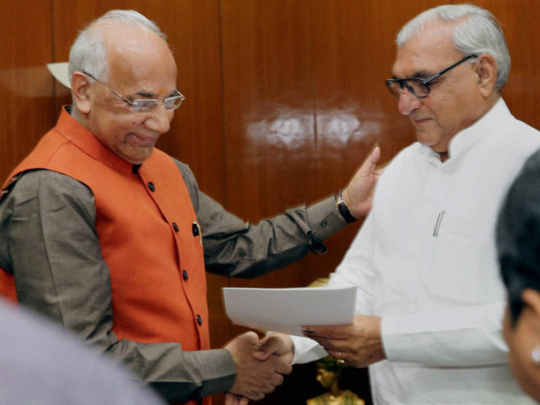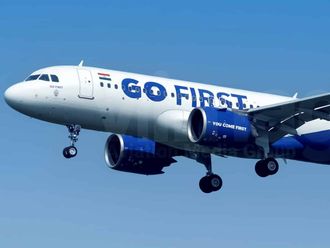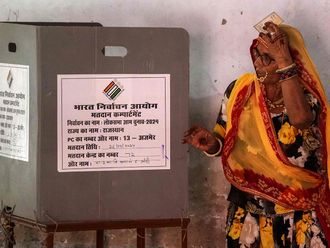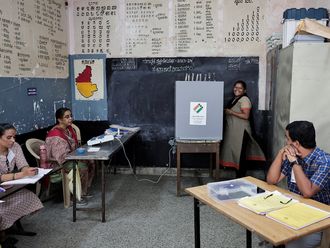
NEW DELHI The BJP snatched power from the Congress in Haryana on the back of a dramatic surge in vote share which saw its tally zooming from 4 to 47 in the 90-member house.
BJP’s vote share rocketed to 33.2 per cent from a meagre 9.05 per cent in the last Assembly polls in 2009.
The Modi wave crumbled the bastions of Congress, which was in power for the last 10 years with Sonia Gandhi-led party’s vote percentage dropping from 35.12 per cent to 20.6 per cent in this election.
The results negated all suggestions Prime Minister Narendra Modi’s popularity was on the wane after a string of defeats in assembly by-elections in various states, including Gujarat where Modi served as the chief minister before taking over as the country’s prime minister in May this year.
The BJP took a calculated risk by snapping ties with two regional allies — Haryana Janhit Congress in Haryana and Shiv Sena in Maharashtra. The idea was to expand its base in the two states where it had shared power in the past as junior partner in the provincial governments.
The move to go to voters without naming its chief ministerial candidates and seek votes in Modi’s name was also questioned. Opponents criticised Modi for campaigning extensively in both states saying Modi had lowered the prestige of the prime minister’s office.
At the end of it all, the BJP’s gambit paid off as the BJP got majority on its own in Haryana and emerged as the single largest party in Maharashtra where too it is poised to form the government with the outside support of the Nationalist Congress Party (NCP). The NCP was junior partner to the Congress party in the alliance government that ruled Maharashtra for 15 years.
What came as a big surprise was its clean sweep in Haryana where it had no organisation and workers. The party did not have even suitable candidates to contest all 90 seats and had to engineer defections from rival parties to be considered a serious contender for power. However, Modi’s 11 rallies worked the magic with BJP leapfrogging from four seats it had won five years ago to 47.
With a 24 per cent rise in its vote share, the BJP on its own is all set to form the government for the first time in the state where it has always been a fringe player. It had been earlier playing second fiddle to the regional parties in Haryana, including INLD that has now finished second. The outcome was virtually a mirror image of the Lok Sabha elections held in April-May which had seen BJP capturing seven of the 10 parliamentary seats in the state, leaving two for INLD and one to Congress.
The BJP Parliamentary party board met in New Delhi Sunday evening to discuss probables for the post of the party’s first chief minister in the state.
The names doing rounds include Rashtriya Swayamsevak Sangh activist Manohar Lal Khattar, state BJP president Ram Bilas Sharma and BJP spokesperson Abhimanyu. Other names of leaders who did not contest, include union ministers Sushma Swaraj, Rao Inderjit Singh and Krishan Pal. Congressman-turned-BJP leader Birender Singh is also in the running.
Senior party sources told IANS the new government could be sworn in before Diwali this week. The Hindu festival of lights falls on October 23.
Outgoing Haryana Chief Minister Bhupinder Hooda accepted defeat and submitted his resignation to Governor Kaptan Singh Solanki.
The BJP’s win in Haryana is a big achievement given the fact that it had won only four seats in the 2009 assembly polls. Its highest ever tally in Haryana was 16.
Kailash Vijayvargiya in charge of the BJP’s party affairs in Haryana, said: “People of Haryana wanted a change. Our party cadres and leaders worked very hard. The credit for our success has to go to Prime Minister Narendra Modi and BJP chief Amit Shah.”
Maharashtra bashing
BJP president Amit Shah lost no time in hitting out at the Shiv Sena in Maharashtra by reminding that BJP had won more seats than the Shiv Sena had offered to his party before they parted ways after seat sharing talks broke down. As against 123 seats to BJP, Shiv Sena could manage just 61 seats emerging as the second largest party.
BJP was predicted to emerge the single largest party and fall just short of the majority in Maharashtra.
The twin victories have not only flattened the rivals who were saying Modi’s popularity had declined due to his government’s failure to fulfil its promises and control price rise but also his critics sidelined within the BJP who were waiting in the wings to make his life uncomfortable after failures in both states blaming his brash style of functioning.
The twin victories will increase the number of BJP-ruled states to seven giving fresh hopes to Modi’s dream of making India Congress-free. It has also given fresh impetus to BJP’s hopes of capturing another two opposition-ruled states, namely Jharkhand and Jammu and Kashmir where state assembly polls are towards the end of this year.
— With agency inputs












